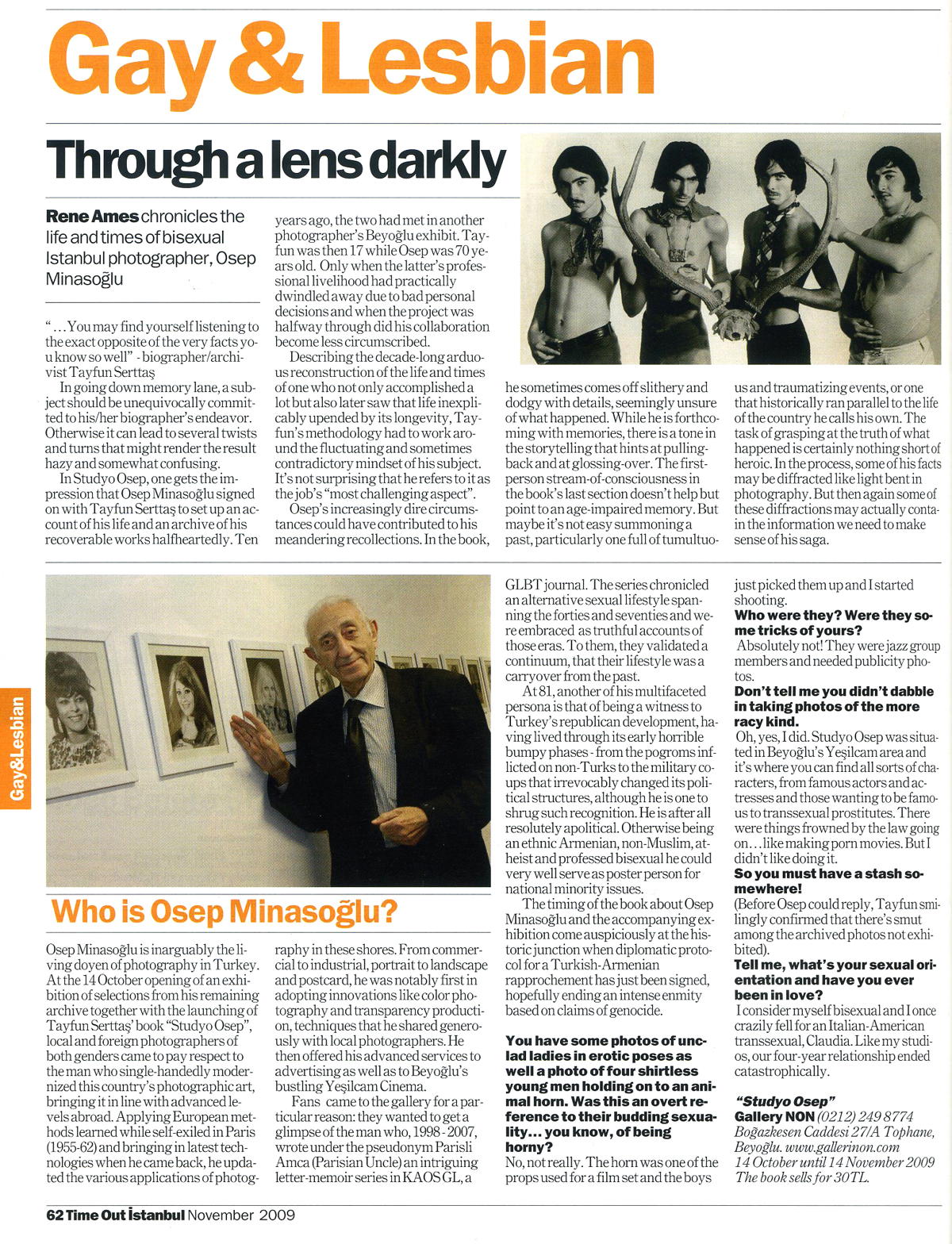Through a Lens Darkly
Rene Ames chronicles the life and times of bisexual Istanbul photographer, Osep Minasoğlu.
by Rene Ames
“…You may find yourself listening to the exact opposite of the very facts you know so well” – biographer / archivist Tayfun Serttaş.
In going down memory lane, a subject should be unequivocally committed to his / her biographer’s endeavor. Otherwise it can lead to several twists and turns that might render the result hazy and somewhat confusing.
In Studyo Osep, one gets the impression that Osep Minasoğlu signed on with Tayfun Serttaş to set up an account of his life and an archive of his recoverable Works halfheartedly. Ten years ago, the two had met in another photographer’s Beyoğlu exhibit. Tayfun was then 17 while Osep was 70 years old. Only when the letter’s professional livelihood had practically dwindled away due to bad personal decisions and when the project was halfway through did his collaboration become less circumscribed.
Describing the decade-long arduous reconstruction of the life and time of one who not only accomplished a lot but also later saw that life inexplicably upended by its longevity, Tayfun’s methodology had to work around the fluctuating and sometimes contradictory mindset of his subject. It’s not surprising that he refers to it as the job’s “most challenging aspect”.
Osep’s increasingly dire circumstances could have contributed to his meandering recollections. In the book, he sometimes comes of slithery and dodgy with details, seemingly unsure of what happened. While he is forthcoming with memories, there is a tone in the storytelling that hints at pulling-back and at glossing-over. The first-person stream-of-consciousness in the book’s last section doesn’t help but point to an age-impaired memory. But maybe it’s not easy summoning a past, particularly one full of tumultuous and traumatizing events, or one that historically ran parallel to the life of the country he calls his own. The task of grasping at the truth of what happened in certainly nothing short of heroic. In the process, some of his facts may be diffracted like light bent in photography. But then again some of these diffractions may actually contain the information we need to make sense of his saga.
Who is Osep Minasoğlu?
Osep Minasoğlu is inarguably the living doyen of photography in Turkey. At the 14th October opening of an exhibition of selections from his remaining archive together with the launching of Tayfun Serttaş’s book “Studyo Osep”, local and foreign photographers of both genders came to pay respect to the man who single-handedly modernized this country’s photographic art, bringing it in line with advanced levels abroad. Applying European methods learned while self-exiled in Paris (1955-62) and bringing in latest technologies when he came back, he updated the various applications of photography in these shores. From commercial to industrial, portrait to landscape and postcard, he was notably first in adopting innovations like color photography and transparency production, techniques that he shared generously with local photographers. He then offered his advanced services to advertising as well as to Beyoğlu’s bustling Yeşilçam Cinema.
Fans came to the gallery for a particular reason: they wanted to get a glimpse of the man who, 1998-2007, wrote under the pseudonym Parisli Amca (Parisian Uncle) an intriguing letter-memoir series in KAOS GL, a GLTB journal. The series chronicled an alternative sexual lifestyle spanning the forties and seventies and were embraced as truthful accounts of those eras. To them, they validated a continuum, that their lifestyle was a carryover from the past.
At 81, another of his multifaceted persona is that of being a witness to Turkey’s republican development, having lived through its early horrible bumpy phases – from the pogroms inflicted on non – Turks to the military coups that irrevocably changed its political structures, although he is one to shrug such recognition. He is after all resolutely apolitical. Otherwise being an ethnic Armenian, non – Muslim, atheist and professed bisexual he could very well serve as poster person for national minority issues.
The timing of the book about Osep Minasoğlu and the accompanying exhibition come auspiciously at the historic junction when diplomatic protocol for a Turkish-Armenian rapprochement has just been signed, hopefully ending an intense enmity based on claims of genocide.
You have some photos of unclad ladies in erotic poses as well a photo of four shirtless young men holding on to an animal horn. Was this an overt reference to their budding sexuality… you know of being horny?
No, not really. The horn was one of the props used for a film set and the boys just picked them up and I started shooting.
Who were they? Were they some tricks of yours?
Absolutely not! They were jazz group members and needed publicity photos.
Don’t tell me you didn’t dabble in taking photos of the more racy kind.
Oh yes, I did. Studyo Osep was situated in Beyoğlu’s Yeşilçam area and it’s where you can find all sorts of characters, from famous actors and actresses and those wanting to be famous to transsexual prostitutes. There were things frowned by the law going on… like making porn movies. But I didn’t like doing it.
So you must have a stash somewhere!
(Before Osep could reply, Tayfun smilingly confirmed that there’s smut among the archived photos not exhibited.)
Tell me, what’s your sexual orientation and have you ever been in love?
I consider by myself bisexual and I once crazily fell for an Italian-American transsexual, Claudia. Like my studios, our four-year relationship ended catastrophically.
